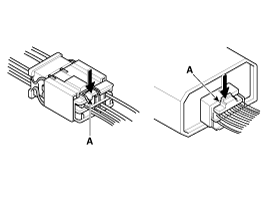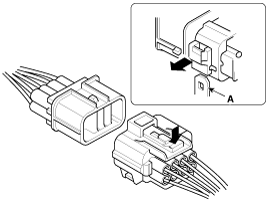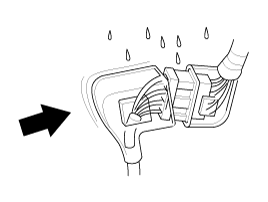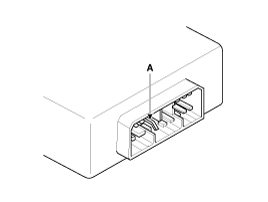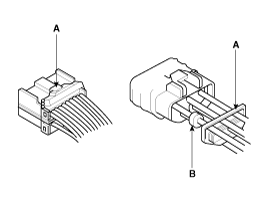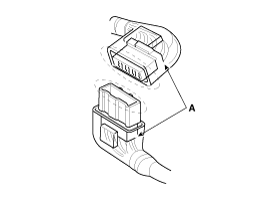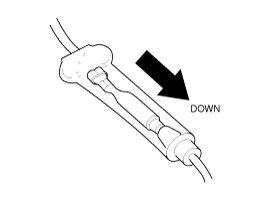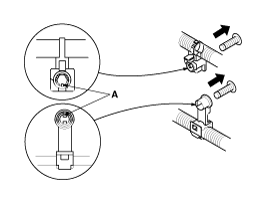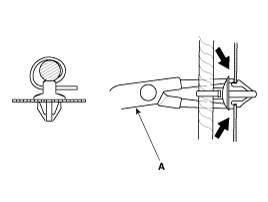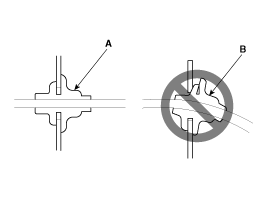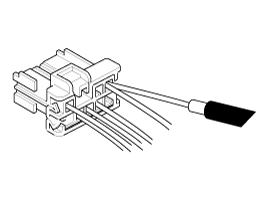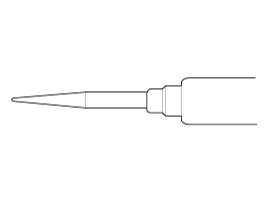 Kia Sedona: General Information
Kia Sedona: General Information
Third generation YP (2014-2026) / Kia Sedona YP Service Manual / Body Electrical System / General Information
| General Troubleshooting Information |
Before Troubleshooting
| 1. |
Check applicable fuses in the appropriate fuse/relay box. |
| 2. |
Check the battery for damage, state of charge, and clean and tight connections.
(Refer to Engine Electrical System - "Battery")
|
| 3. |
Check the alternator belt tension (D). |
Handling Connectors
| 1. |
Make sure that the connectors are clean and have no loose wire terminals. |
| 2. |
Make sure that multiple cavity connectors are filled with grease (except for watertight connectors). |
| 3. |
All connectors have push-down release type locks (A).
|
| 4. |
Some connectors have a clip on their side used to attach them
to a mount bracket on the body or on another component. This clip has a
pull type lock. |
| 5. |
Some mounted connectors cannot be disconnected unless the
lock is released and the connector is removed from its mount bracket (A)
first.
|
| 6. |
Never try to disconnect connectors by pulling on their wires; pull on the connector halves instead. |
| 7. |
Always reinstall plastic covers.
|
| 8. |
Before connecting connectors, make sure that the terminals (A) are in place and not bent.
|
| 9. |
Check for loose retainer (A) and rubber seals (B).
|
| 10. |
The back of some connectors are packed with grease. Add grease if necessary. If the grease (A) is contaminated, replace it.
|
| 11. |
Insert the connector all the way and make sure that it is securely locked. |
| 12. |
Position wires so that the open end of the cover faces down.
|
Handling Wires And Harnesses
| 1. |
Secure wires and wire harnesses to the frame with their respective wire ties at the designated locations. |
| 2. |
Remove clips carefully; don''t damage their locks (A).
|
| 3. |
Slip pliers (A) under the clip base and through the hole at an angle, and then squeeze the expansion tabs to release the clip.
|
| 4. |
After installing harness clips, make sure that the harness doesn''t interfere with any moving parts. |
| 5. |
Keep wire harnesses away from exhaust pipes and other hot
parts, from sharp edges of brackets and holes, and from exposed screws
and bolts. |
| 6. |
Seat grommets in their grooves properly (A). Do not leave grommets distorted (B).
|
Testing and Repairing
| 1. |
Do not use wires or harnesses with broken insulation.
Replace them or repair them by wrapping the break with electrical tape. |
| 2. |
After installing parts, make sure that no wires are pinched under them. |
| 3. |
When using electrical test equipment, follow the manufacturer''s instructions and those described in this manual. |
| 4. |
If possible, insert the remover tool from the wire side (except for waterproof connector).
|
| 5. |
Use a probe with a tapered tip.
Refer to the user''s guide in the wiring repair kit (Pub No. : TRK 015.)
|
Five-step Troubleshooting
| 1. |
Verify the complaint
Turn on all the components in the problem circuit to verify
the customer complaint. Not the symptoms. Do not begin disassembling or
testing until the problem area has been narrowed down. |
| 2. |
Analyze the schematic
Look up the schematic for the problem circuit.
Determine how the circuit is supposed to work by tracing the
current paths from the power feed through the circuit components to
ground. If several circuits fail at the same time, the fuse or ground is
a likely cause.
Based on the symptoms and your understanding of the circuit operation, identify one or more possible causes of the problem. |
| 3. |
Isolate the problem by testing the circuit.
Make circuit tests to check the diagnosis you made in step 2.
Keep in mind that a logical, simple procedure is the key to efficient
troubleshooting.
Test for the most likely cause of failure first. Try to make tests at points that are easily accessible. |
| 4. |
Fix the problem
Once the specific problem has been identified, start
repairing. Make sure that proper tools are used and safe procedures are
followed. |
| 5. |
Make sure the circuit works
Turn on all components in the repaired circuit in all modes
to make sure that the entire problem has been fixed. If the problem was a
blown fuse, test all circuits on the fuse. Make sure that no new
problems turn up and the original problem does not recur. |
Installation of the transmitting device
Electronically controlled computers are designed to be not
interrupted by other radio frequencies or signals, however, they can be
slightly affected by wiring of the antenna or the peripheral cables.
Follow the directions below:
| 1. |
Mount the antenna on the roof or rear-bumper. |
| 2. |
Antenna cables should be at a distance of over 200 mm from
the computer or wiring harness as antenna cables transmit radio signals. |
| 3. |
Decrease the standing-wave ratio by using proper antennas and cables. |
| 4. |
Not to install remote-control with a high output. |
| 5. |
Check the status of an engine by generating radio signals at idle.
|
Battery Reset
| Description |
When reconnecting the battery cable after disconnecting,
recharging battery after discharged or installing the memory fuse
located on the driver''s side panel after removing, be sure to reset
systems mentioned on the below table.
In addition, when replacing or reinstalling their fuses after
removing, they should be reset according to the below table. Please
refer to the below table when servicing.
| System | Resetting | ||||||
| Auto up/down window | Whenever
the battery is disconnected, discharged or the related fuse is replaced
or reinstalled, reset the Auto up/down window system according to the
procedure below. 1) Turn the ignition switch to the ON position. 2) Pull up the power window switch in order that the window can close completely, and then keep pulling up the power switch for about 1 second. | ||||||
| Panoramaroof | If
the sunroof glass or the roller blind does not move when One-Touch
operation of the switch is activated or only moves by manually holding
down the switch, the default setting must have been deleted. In this
case, the sunroof must be reset in the procedure below: 1) Turn the ignition key to the ON position and then use CLOSE switch to fully close the sunroof glass and roller blind. 2) When the glass and the roller blind is fully closed, release the CLOSE switch and then press and hold down the switch (about 10 sec.) until the glass and the blind moves slightly one time. 3) Release the CLOSE switch and then press and hold down the switch again, and the glass and the blind opens and closes in below order and completes Sunroof Reset process.
| ||||||
| Trip computer | When
the battery is disconnected and reconnected, the set functions of the
trip computer initializes. So, you need to explain this information to
the customer. | ||||||
| Clock | Whenever the battery terminals or related fuses are disconnected, you must reset the time in audio head unit. (Refer to Audio owner''s manual) | ||||||
| Audio | When
the battery is disconnected and reconnected, the customer''s radio
stations become initialized. So, you need to record the customer''s
radio stations prior to service, and after service, set the customer''s
radio stations into the audio. |
 Special Service Tools
Special Service Tools
Special Service Tools
Tool Name / NumberIllustrationDescriptionRKE Battery Checker09954-2P100Measuring the RKE batteryvoltageCorrection jig for LDWS or LKAS09890-3V100Correction of LDWS (Lane Dep ...
Other Information:
Foward collision warning system (FCWS)
The Foward Collision Warning System helps avoid accidents by identifying critical
situations early and warning the driver. ...
A/V Mode
This mode displays the state of the A/V system. ...
Categories
- Home
- First Generation
- Second Generation
- Third generation
- Kia Sedona YP 2014-2026 Owners Manual
- Kia Sedona YP 2014-2026 Service Manual
Copyright © www.kisedona.com 2016-2026


